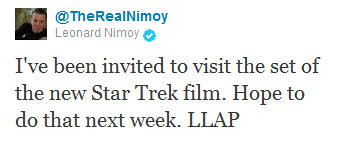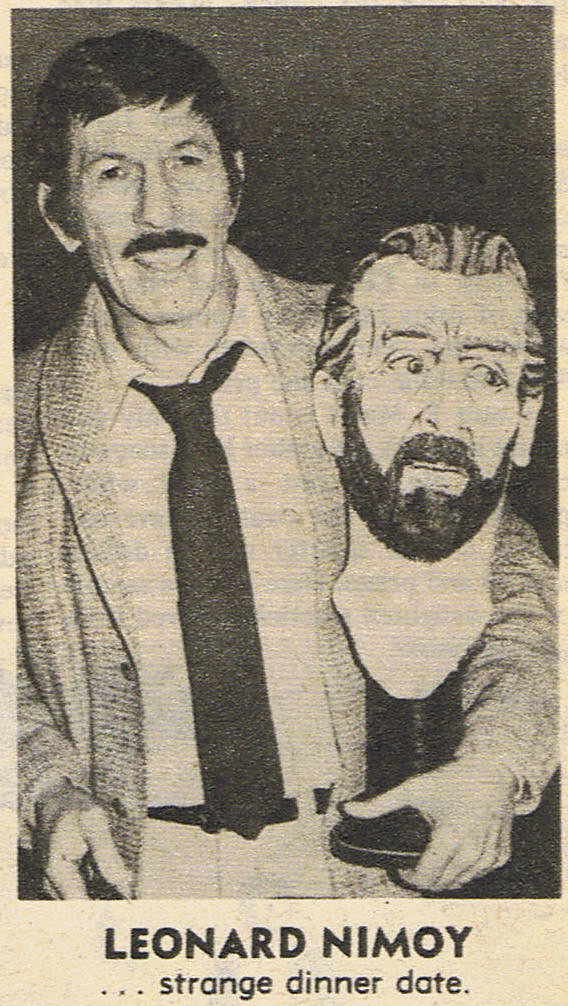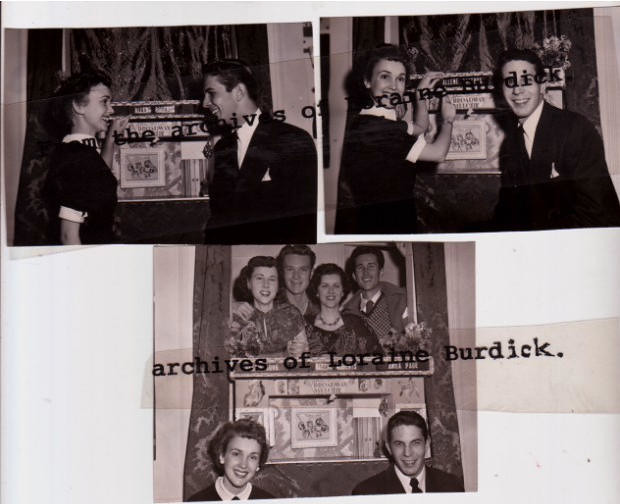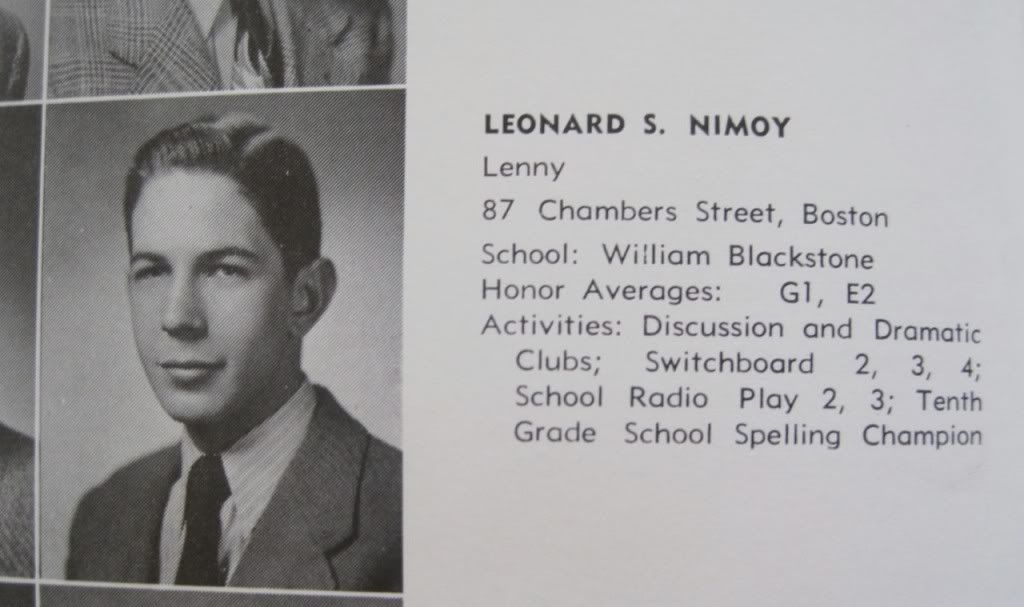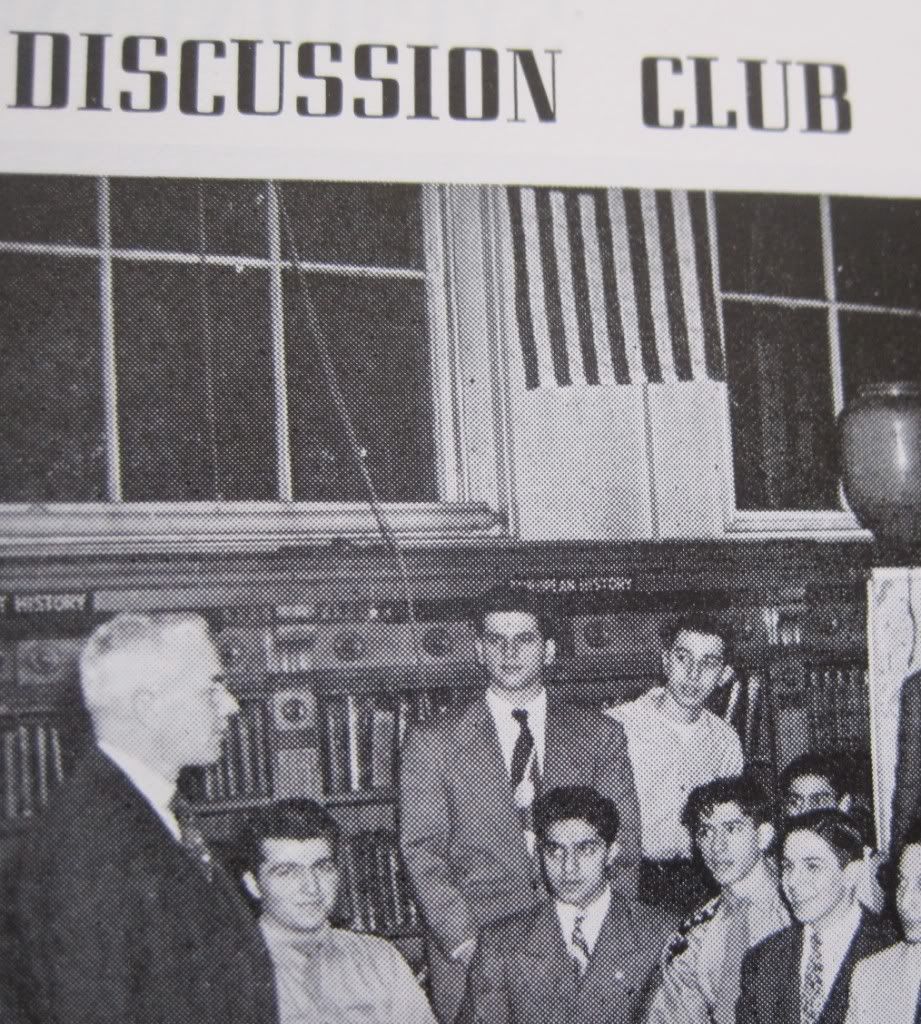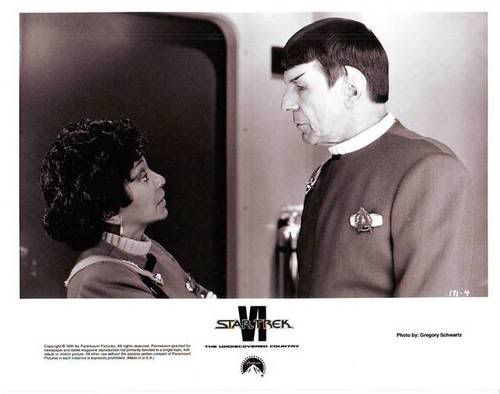What's New January 2012
Recordings
Mr. Nimoy's reading of Raymond Carver's “'What We Talk About When We Talk About Love,' in which two hard-drinking couples review their lives and loves" is available on the Selected Shorts webpage.
Many thanks go to Grace for the alert.
Please let there be many photos of that. And I'd be on overload if Benedict Cumberbatch would be there, too.
Another Sherlock Thought (Contains References to Ep. 2x03, Spoiler Alert if you haven't seen it)
Jackie, you asked me if I saw another connection between Spock and Sherlock in " the similarity between Watson's heart-tearing speech over Sherlock's grave, and Kirk's eulogy over Spock's coffin in STII," and I have to wholeheartedly say YES.
After saying that Sherlock told him once he wasn't a hero and that he didn't think Sherlock was even human at times, came the part where John spoke of Sherlock as the "best man and most human..." and choked and paused on the word human. Was I reminded of ST II? You bet. And of course there is the part before that where John and Sherlock are physically separated, unable to touch during Sherlock's last moments?
Well, if you borrow, borrow from the best. (And the BBC, via YouTube, wouldn't even let me upload that clip where Watson calls Sherlock "Spock." Hrmpf.) There is another basic appeal to the character of Sherlock he shares with Spock, as viewers wait for those special moments where his humanity would peak through. And when it does, at the moment you realize that Sherlock is crying, it shatters your heart into a thousand tiny little pieces. But there the similarities end, as Sherlock describes himself as a highly functioning sociopath and elsewhere has been compared to Dr. House. Sherlock definitely has a sadistic streak in him. The way he delivers the deathblow to the convict through a grammar lesson in the opening scene of The Great Game is cruel and he leaves the scene with a satisfied smirk on his lips. There is a promise, though, that Sherlock is redeemable that is offered through the presence of John Watson who becomes his link to humanity and moral compass. Like Kirk and Spock, Sherlock and John only become more than the sum of their parts through the other's friendship. Sherlock, the man who didn't give a shit about what others think of him, has learned to care. It would be easy to say that the needs of the many outweigh the needs of the one when Sherlock has to face suicide in The Reichenbach Falls, but that's not the case. Of the three targets identified by Moriarty as Sherlock's friends, only John really matters. To ensure his survival, Sherlock has be cruel to him and for probably the first time in Sherlock's life, cruelty does not bring pleasure but pain. It's essential that John believes in Sherlock's death and Sherlock knows exactly what it would do to him.
All comparisons aside, in the cobination of character traits, manerisms, composure and the actor's talents behind it, a truely unique character was created. As someone posted on Tumblr, " Benedict Cumberbatch is our generation's Leonard Nimoy, his Sherlock is our Mr. Spock."
One last bit of trivia before I end, Benedict Cumberbatch has been playing Vincent van Gogh in a British docu-drama Van Gogh - Painted with Words.
"Sherlock" and Spock
My apologies for the lack of updates recently, but I had to get the Baker Street boys out of my system first by doing a music video. The actor, Benedict Cumberbatch, who portraits Sherlock Holmes in the hit BBC series was announced to be playing a part in the next Star Trek movie currently filming at Paramount. He is rumored to play the villain and today in the comments at TrekMovie I read that some even conjecture he might play a Vulcan from a remark made by Zachary Quinto. Since J.J. Abrams is coy about even calling the part in the movie a villain, there is much room for speculation. Whatever the case may be, both franchises have already been tied in the past by director and Holmes fan Nicholas Meyer in The Undiscovered Country where he has Spock citing Sherlock Holmes. The favor was returned only recently in a dialog in Sherlock's second season episode, The Hounds of Baskerville. Watson calls Sherlock "Spock" after Sherlock lectures him on the messy effects of emotions and the necessity to divorce himself from them to function adequately. Fans of Mr. Nimoy of course already know there is one more connection left to mention, since he, too, tried his hand at playing Sherlock Holmes in the past on stage.

The text on the picture taken to promote the play in 1976 reads, "Leonard Nimoy and Alan Sues, appearing at the Shubert in 'Sherlock Holmes', temporarily man the State Street Council Information booth at the NE Corner of State and Madison..... a crowed of fans lines up for autographs and fingerprints provided by the stars...."
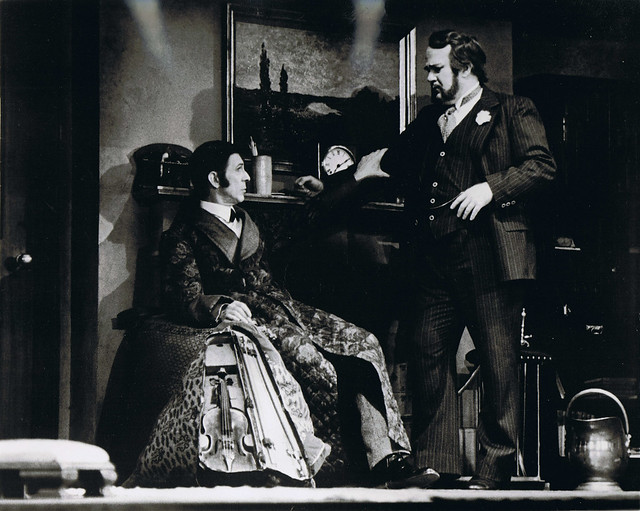
"Leonard Nimoy as 'Sherlock Holmes' comforts his ally and dear friend Doctor Watson in a dramatic moment in the international hit coming to the stage of the Shubert [Theater] for a limited [engagement] beginning Tuesday, May 11. Doctor Watson is played by Ronald Bishop."
Interviews
Leonard Nimoy at 80: 'Practicing Life'
On Judaism, Spock and Spirituality
From 1966 to 1969, Leonard Nimoy played Mr. Spock on the original Star Trek series. Those three years as a half-human, half-Vulcan science fiction character would change his life, making him the public face of one of the most popular franchises in television history.
But there is an intensely private, spiritual side of Leonard Nimoy that isn’t as well known. The son of a barber, Nimoy grew up in an Orthodox Jewish family in Boston, where he became captivated by the mystery and poetry of Jewish rituals. His interest in Judaism has stayed with him, informing his work as a poet, photographer, and even his portrayal of Mr. Spock.
He spoke to Nadine Epstein, editor of Moment Magazine, the national independent Jewish publication co-founded by Elie Wiesel. This is part of our collaboration with Moment that explores great Jewish artists and thinkers.
Submitted by Grace. Many Thanks. Listen or download the interview here.
Shekhina Interview ca. 2002
Three Men and a Baby
The movie made the Sydney Morning Herald's list of "Top five: American remakes of foreign films." Their verdict is justified thus:
4. Trois Hommes et un Couffin (1985, France) becomes Three Men and a Baby (1987)
SOME humour doesn't translate across the language barrier but some comedic topics are universal, such as offering $1000 to get somebody else to change a nappy. Leonard Nimoy's best non-Star Trek film as director.
Submitted by Grace. Thank you.
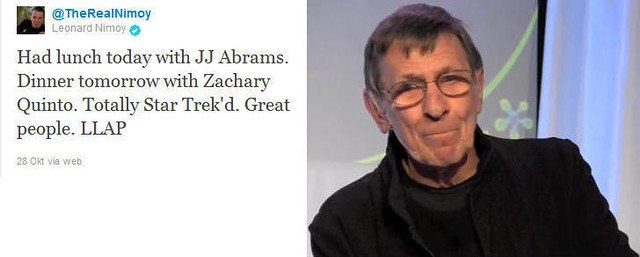
Is my imagination getting the best of me? J.J. Abrams starts shooting Star Trek soon again. Mr. Nimoy's hair is long again and his eyebrows appear shaved??? I don’t want to start any false rumors here, so please watch the video of the DEMO conference yourself and let me know if I’m seeing things… (For comments via Disqus an email address that won't be displayed needs to be entered.)
CALL and RESPONSE I: the art of Leonard Nimoy
An art project inspired by Mr. Nimoy's photos at Mastodon Mesa Gallery
March 22, 2011 – May 6, 2011
opening reception March 22 5:00pm- 8:30pm
Artists:
Leonard Nimoy
Ivory Lee Carlson
Megan May Daalder
Steven Andrew Garcia
Zena Grey
Lisa Katnic
Sage Keeler
Luke McGowan
James Merson, Kevin Blechdom & William Hutson
Suki-Rose Otter
Adam Villacin
Dorian Wood
“Call and response,” or antiphony, is a musical technique employed by various cultures, in which one partner offers a phrase, and, in turn, a second partner generates a phrase which connects in some way to the first.
Two of the most ancient traditions of call and response are found in African and Indian cultures:
Sub-Saharan Africa: this tradition has many echoes in contemporary American culture. It is part of what anthropologists regard as a “pervasive pattern of democratic participation” in the civic affairs and religions of the region.
Characteristically, a leader makes a statement, and the responder affirms it.
Those who are witnessing, speaking, or singing are encouraged by the responses and those who are about to experience issues are empowered to be victorious. — Brother Dennis L. Slaughter, History of Gospel Music
Sawaal-Javaab: “question and answer” is a tradition of North Indian classical music, in which one player issues a challenge to the other, who either replicates it identically, or embellishes it.
It is both competitive and collaborative. The two participants are friendly rivals. — Sound of India
Part of the fascination of this concept for Mastodon Mesa is the role this very same technique plays in the lives of…parrots.
Parrots are a prey animal, and therefore form flocks for safety in numbers. As they spend their days ranging over miles of thick forest seeking food, they have developed “contact calls,” in which one bird will make a characteristic sound, such as a complex whistle, which is given a particular response by either all who can hear it, or a specific addressee.
These sophisticated, proto-linguistic behaviors are complete with regional dialects and variations between individuals – all for reassurance that even when other parrots are out of eyesight, the bird is not alone, he or she is still a part of a warm, close flock.
Underneath the exponential increase in complexity, how much of human communication – the production of art included – is exactly the same?
The Calls: Leonard Nimoy
The calls have been selected from among the body of work of Leonard Nimoy as a photographer. Though many of the show’s participants, and likely, audience, are very familiar with Nimoy as an actor, he has maintained a less widely known lifelong artistic practice.
In the context of this show, it is particularly intriguing to perceptually liberate the voice of Nimoy from the familiarity of performances embedded in the assembly-line process of popular culture, and to instead have the chance to examine these photos as wordless “calls” of unadulterated communication from the individual artist.
The Responses
The responses will be drawn from emerging young artists local to Los Angeles.
Curated by: Mya Stark & Suki-Rose Otter
Call and Response I: Leonard Nimoy
Young artists respond to Leonard Nimoy's artwork
why is there art, or indeed any form of communication? no one involved in this Mastodon Mesa art show claims to know.
what we do know: why there are art shows. or at least why there's this one: for curators, audiences and artists to think about an interesting idea together in a loose, unrestrained way that leads to a stimulating experience.
what's the idea: well, there's something in music called "call and response" -- one participant sings or plays a line, and another participant or chorus sing or play something imitating or based on it.
and, there's a parrot behavior called "contact calls" -- parrots are very social creatures, they flock together for safety because they are prey animals -- yet they have to spread out to search for food.
these sophisticated, proto-linguistic calls are complete with regional dialects and variations between individuals all for reassurance that even when other parrots are out of eyesight, the bird is not alone, he or she is still a part of a warm, close flock.
the structure for the show is: with these thoughts in mind, to take a sampling of the body of work of one artist, and utilize it as "calls" for responses by a group of other, wildly eclectic individuals with varying creative practices, from painting to neuroscience.
what's Spock got to do with it: while best known to many of us as an actor, Leonard Nimoy is a respected art photographer too, and he and his gallery, were open-minded and generous enough to provide the "calls" for the following artists:
Ivory Lee Carlson Megan May Daalder Suki-Rose Otter Steven Andrew Garcia Zena Grey Lisa Katnic Sage Keeler Lola Loshkey Luke McGowan James Merson, Kevin Blechdom & William Hutson Adam Villacin Dorian Wood
Works so far include: a human antenna who will be receiving radio signals with his body, a performance artist dressed as a giant tomato, "finger whiskers," and a wall of video skin.
what have you got to do with it: you are curious and playful enough to wish for silly, thoughtful things like this to be born.
who are we? Mastodon Mesa is a non-profit community-run collective, located in the PDC as part of the Design Loves Art program.
Source: INDIGOGO
WWLNS
Lotus Awards: Best Social Media Single or Multi-Platform Campaign - "What would Leonard Nimoy Say?" (November 10th, 2011)
"The annual Lotus Awards is a competitive advertising awards show that celebrates creative excellence in British Columbia. Established in 1989, the Lotus Awards show was founded by the West Coast advertising community to recognize outstanding creative work of individuals, companies and agencies in BC. Originally just an ‘advertising’ show, the Lotus Awards have been expanded in recent years to include design, interactive, social media and direct mail. "
A review of the Facebook App can be found here.
DEMO Enterprise Conference
SAN FRANCISCO (KGO) -- A meeting of the tech minds took place Thursday night at Temple Nightclub in San Francisco. Steve Wozniak and Leonard Nimoy were on hand for Demo Enterprise Disruption: An Evening Of Change And Innovation.
It was an opportunity for Wozniak's company, Fusion-io, and student companies to show off their products to potential investors. The Woz and the actor best known as "Spock" on "Star Trek" took to the stage to trade personal stories, including meeting for the first time in Moscow.
"...And a group of people passed us and after they passed us, the people that I was with said to me, 'I think that was Steve Wozniak that just went by,'" said Nimoy.
"I think my people told me 'That's Leonard Nimoy,'" said Wozniak.
Source: ABC
Leonard “Mr. Spock” Nimoy speaks at DEMO
We were honored to have Leonard Nimoy, best known as Star Trek’s Mr. Spock, as one of our speakers last night.
VentureBeat and DEMO produced the event, which was hosted by Fusion-io, a leader in efficient server technology.
As we gathered to discuss large-scale innovations and future-focused technologies, we were joined by Mr. Nimoy, who shared some of his thoughts on how science fiction of the past is becoming the scientific and technological reality in the present.
Nimoy is in a unique position. Having been a fundamental part of the most influential science fiction series (arguably) ever, he’s associated with science and technology. But the man is an artist — he’s an actor by profession and also an excellent photographer
But he realizes that curiosity and creativity drive both of these disparate pursuits, and he shares the importance of those two virtues with us, both through his words and his character.
If there’s one thing I learned from listening to Mr. Nimoy both on- and offstage last night, it’s that he is completely devoid of arrogance or complacency; and his wide-eyed, unpretentious approach to people and ideas is part of what makes him so inspiring. He is endlessly inquisitive, and he showed us that he is willing to learn, whether from great minds like that of Steve Wozniak or from mere passers-by whose only commendations are the new bits of information they possess.
His attitude was (to me, at least) a stark and refreshing contrast to the know-it-all aura we technologists sometimes acquire. When we involve ourselves with the day-to-day creation of the tools the future world will use, we tend to become a bit blasé, to acquire a certain road-weariness or ennui. We are distrustful of others’ ideas when we ought to be open-minded, and we are critical when we ought to be encouraging, for innovation’s sake.
Nimoy ended his prepared remarks with a quotation from famous science fiction author Arthur C. Clarke: “When a distinguished but elderly scientist states that something is possible, he is almost certainly right. When he states that something is impossible, he is very probably wrong.”
I hope that we, like Nimoy, continue to explore our own strange, new worlds with enthusiasm and fresh eyes, and to innovate without regard for the realm of the impossible.
Source: Venture.Beat
Demo fusion io from Venturebeat on Vimeo.
Matt interviews Woz and Leonard Nimoy from Venturebeat on Vimeo.
VBWeekly from Venturebeat on Vimeo.
Narrator
An American Synagogue - Frank Lloyd Wright, Rabbi Mortimer J. Cohen and the Making of Beth Sholom
An American Synagogue - Frank Lloyd Wright, Rabbi Mortimer J. Cohen and the Making of Beth Sholom from Alison Cornyn on Vimeo.
This clip is a brief introduction to a documentary video created for Beth Sholom Synagogue's Visitor Center and the Synagogue's Preservation Foundation in order to bring awareness to the 50th anniversary of Beth Sholom, the only synagogue to be designed by Frank Lloyd Wright. The film, narrated by Leonard Nimoy and written by James Sanders, is co-directed by Alison Cornyn and James Sanders and produced by Picture Projects in Brooklyn, NY. The full 22 minute film can only be seen upon visiting the Synagogue.
Voices - StarTrek.com interview with Robin Curtis - Updated 01/07/12
Part 1
Let’s go back to Star Trek III. How many times did you audition for the role of Saavik?
Curtis: I remember the process very, very, very clearly. I interviewed with the casting people. That really wasn’t an audition, because there was nothing to read. Almost a day to two days later I met Leonard Nimoy one on one. That was first time I read any sides, as it were, from the script. I did not audition again until the screen test. So it was the gentlest experience. I’d never experienced anything quite like that and I think Leonard had a lot to do with that. Here was an actor stepping out from in front of the character to behind the camera, and I think he had a special empathy with how crazy-making and how anxiety-making that process is for an actor. So he took all the craziness out of it. He videotaped my audition, so I didn’t have to go back and recreate that for Harve Bennett at the producers’ audition or for Gary Nardino at the executive vice-president of Paramount audition. New people always come into each subsequent audition when you go back for callbacks. That never happened on Star Trek III, and it was lovely.
Did Nimoy ever say why, specifically, he chose you?
Curtis: At the end of my first meeting with him he shook my hand. I’ll never forget it. He shook my hand at the door of the office and he said, “I have no doubt that you can do this role. Now it’s up to the powers that be.” Honestly, and I’m not being coy or insincerely modest, but I don’t know why he thought that. I didn’t feel like I was a slam dunk for the role at all. I was so unlike Saavik. I wasn’t self-contained or controlled. There are so many actresses who have that demeanor already, that stoic demeanor. That’s not me at all, then or now. I don’t know how I managed to contain myself, but I guess Leonard felt I succeeded enough to think I could do the role. I remember that one of the phrases that he used to give me a key into the character was “1000 years of wisdom behind the eyes.” Now, who deigns to presume they can exude 1000 years of wisdom behind their own eyes? But that was the term Leonard used to try to get across the depth of Saavik’s intelligence.
Read more here.
Part 2
Your appearance in Star Trek IV ended up being a cameo. You were surely hoping for more. What happened?
Curtis: That was just such a weird left curve, to be honest. Given what had happened with Kirstie Alley, they negotiated for each film after the third, for the fourth, the fifth and the sixth. For somebody who’s 28 years old and had never made than a few bucks a year, that’s quite an event, to have a contract that provided for three films in years to come. Then, weeks and weeks before the filming (on Star Trek IV) was to begin – and the contract would then be void, because it had a timeframe on it – my people were reaching out to Paramount, saying, “What’s going on?” They wouldn’t say anything. They wouldn’t reveal. They kept putting us off. That, of course, raised a flag. “Something’s not right. This character isn’t being groomed. They will not be following the storyline that we had been led to think they would,” which was that Saavik would be pregnant and there’d be this whole connection between her and Spock. Lo and behold, all this hope that there might be greater involvement for the character turned into those few lines.
Was there more, even just on paper?
Curtis: It was just slightly more than that and then it got ratcheted down to even less when the shooting actually occurred. I do think there were a couple of lines that might have hinted that something was going on with her, and those were eliminated. So I handed over the disk and simply wished him a journey free of incident, and that was it. That was such a comedown from where they had led me to think it would go. The band-aid for me at the time was I thought the film was fabulous. I thought they’d returned to the winning recipe for Star Trek, a really simple message about the preservation of life, great use of the ensemble and giving each of the actors their own little moments, and I thought the humor came back tenfold. I thought that was all good stuff.
OK, now do us a big favor and settle an issue. Some fans argue that Saavik was Vulcan-Romulan and not just Vulcan. It's an important distinction because there are people who compare your performance to Kirstie Alley's and describe yours, for better or worse, as far more Vulcan-esque. Then there's the whole matter of the Trek novels at the time, including between Khan and Search for Spock, which stated that Saavik was half-Vulcan and half-Romulan. So, what was your understanding about all this?
Curtis: I am so glad you asked this question, and there's a lot of room for discussion on both sides of it. My understanding was that Kirstie Alley and (Khan writer-director) Nicholas Meyer wanted Saavik to be Vulcan and Romulan and he directed her to include elements of both. And the books may have elaborated on that. I'm aware of the argument about the books, in general: Are they or aren't they official, or canon? But in the case of Star Trek III and Saavik, it really didn't matter. Leonard felt that Saavik was Vulcan. That was his choice, and his choice was my choice. I played Saavik the way he asked me to play her. My job as the actress is to do what my director wants, and that's what I did.
Read more here.
One happy fan? - Updated 01/07/12
Leonard Nimoy's former home is sold
The traditional-style Westwood-area house was bought by Leonard Nimoy and his first wife, Sandra Zober, in 1968 when Nimoy was playing Spock on "Star Trek." The buyer paid $1.95 million, more than the asking price.
Source: Los Angeles Times
A virtual tour of the house and photos have been put up at the page of the estate agent. (Thank you Grace, for the news.)
DEMO Enterprise Conference
Steve Wozniak, Leonard Nimoy to speak at DEMO Bay area technology conference
Per MacNN, Apple co-founder and inventor Steve Wozniak will host a talk at a DEMO conference on technology’s past, present and future with special guest Leonard Nimoy, an actor and photographer best known for his role as “Spock” in the Star Trek franchise of TV shows and movies.
More here.
The event will be streamed today, Jan 5th, at venturebeat.com at 6:15 pm PST, they say, but I haven't been able to figure out where on the page or if one needs to sign up for anything... Anyway, I’ll be fast asleep here at the hour it streams in the U.S. Hope somebody else will catch it and tell us about it.
Three Part Series of Interviews About ST III
Harve Bennett and Leonard Nimoy Talk About How to Make a Movie (Feb. 1985, Part 1)
[Harve Bennett:] Bennett says one of his gifts is to be able to work with writers. He can see the whole and then suggest ways in which scenes might be done differently. But Doing the writing, becoming the writer, was another challenge altogether. "I didn't understand all the alcoholics among writers until some of those long days on writing the script after 1 had been away from the typewriter for a number of years. Frightening situation. It's just you one-on-one at a desk. It's the ultimate confrontation. The most extraordinary thing about Leonard was his functioning for me as editor, He would read my drafts. Now, you don't get compliments from Leonard. He's very Vulcan. Very tied in. His passion is contained. He said, 'This is very promising.' I had to adjust to that because I'm an enthusiast. But in the course of his method he challenged me and when I couldn't get what he was trying to say he'd say, 'Let me write a draft.' And he's a good writer. There are pounds of stuff in the screenplay that are pure Leonard. Great relationship. Very beneficial."
(...)
[Leonard Nimoy:] "In the editing process, specifically, the most interesting challenge was how to tell the story and in what sequence. Having seen it on the screen in its rough cut form, we all came to the conclusion that there was something about the juxtapositioning, scene to scene, idea to idea, character to character;it wasn't quite in its proper order. The jigsaw puzzle hadn't quite fallen into place. Gradually we worked our way towards it and discovered what the picture turned out to be. The flow just didn't want to come to life until we repositioned certain of the opening scenes. For example, what we came to ca11 the caper, which was the gathering of the Samurai to steal the Enterprise. In its original form it was scattered in pieces throughout the first third of the film and they were all wonderful, fun pieces. But somehow, when you cut away from each of ,the happenings it was always as though the fun was being interrupted. When you came back to it you had to get geared up to have fun again. And suddenly that little piece would be over and you were being interrupted and taken away from the story again. The one major reconstruction that took place in editing was to put much if not all of that caper together as a piece so that once we start with the idea of Bill Shatner walking up and saying, 'The answer is no, I am therefore going anyway,' it starts. So that piece became a trump within itself whereas it had been originally constructed as several pieces. I think fourteen minutes from the time we first started looking at cuts of the film were cut down to its present condition. Perhaps two or three minutes were cut after the picture went to preview audiences. So we were pretty close to what we had planned to put on the screen. I think that's due in great part to very successful writing and producing for the film."

Exceptional People Magazine-May/June 2011
Feature about the Griffith Observatory and Mr. Nimoy's contribution to it's remodeling. The article runs from scanned page 14 to 19.
Open publication - Free publishing |

